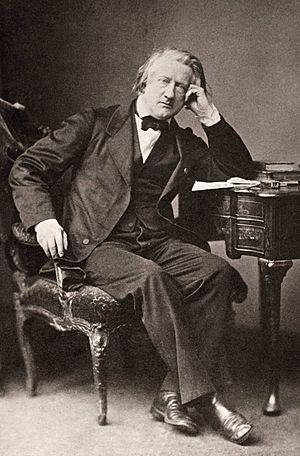Henri Victor Regnault facts for kids
Quick facts for kids
Victor Regnault
|
|
|---|---|
 |
|
| Born |
Henri Victor Regnault
21 July 1810 Aix-la-Chapelle, France
|
| Died | 19 January 1878 (aged 67) Paris, France
|
| Alma mater | École Polytechnique |
| Children | Henri Regnault |
| Awards |
|
| Scientific career | |
| Fields | Thermodynamics |
| Influences | Justus von Liebig |
| Influenced | William Thomson |
Henri Victor Regnault (born July 21, 1810 – died January 19, 1878) was a French scientist. He was both a chemist and a physicist. He is most famous for carefully measuring how gases behave when they get hot or cold. He was one of the first scientists to study thermodynamics, which is about heat and energy. He also taught William Thomson, who later became a very famous scientist. Even though his first name was Henri, everyone knew him as Victor Regnault.
Contents
About Victor Regnault
Victor Regnault was born in 1810 in a city called Aix-la-Chapelle. This city is now known as Aachen in Germany. When he was eight years old, his parents passed away. He then moved to Paris, France.
In Paris, he started working for a company that made furniture covers. He worked there until he was eighteen. In 1830, he got into a famous science school called the École Polytechnique. He graduated from another school, the École des mines, in 1832.
Early Science Work
Victor Regnault worked with a famous chemist named Justus von Liebig. He became very good at a new area of science called organic chemistry. This is the study of chemicals that contain carbon. He created several new chemical compounds that contained chlorine. Some of these include vinyl chloride, which is used to make plastics.
After his early work, he became a chemistry professor at the University of Lyon. In 1840, he became the head of chemistry at the École Polytechnique. The next year, he also became a physics professor at the Collège de France.
Studying Heat and Gases
Starting in 1843, Victor Regnault began a big project. He collected a lot of detailed information about how steam behaves. He published these findings in 1847. His work was so important that it helped Charles Algernon Parsons invent the steam turbine. This machine uses steam to create power.
For his important discoveries, Regnault received the Rumford Medal from the Royal Society of London. He was also made the Chief Engineer of Mines. In 1851, he became a foreign member of the Royal Swedish Academy of Sciences. In 1854, he was chosen to be the director of the famous porcelain factory in Sèvres, France.
At the Sèvres factory, he continued his research on how heat affects different materials. He designed very sensitive tools. These included thermometers to measure temperature and calorimeters to measure heat. He measured how much heat it takes to warm up many different substances. He also studied how much gases expand when they get hot.
During his research, he made an important discovery. He found that not all gases expand in the same way when heated. He also showed that Boyle's Law, which describes how gas pressure and volume are related, is not always perfectly accurate. It's especially not accurate when gases are close to their boiling point.
Photography Hobby
Victor Regnault was also very interested in photography. He was an amateur photographer, meaning he did it for fun. He was one of the first people to use a chemical called pyrogallic acid to develop photos. He was also one of the first to use paper negatives instead of glass ones. In 1854, he helped start and became the first president of the French Photography Society.
Later Life and Challenges
In 1871, during the Franco-Prussian War, Victor Regnault faced great sadness. His laboratory at Sèvres was destroyed. Even more tragically, his son, Alex-Georges-Henri Regnault, passed away. He was so affected by these losses that he retired from science the next year. He never fully recovered from this difficult time.
Victor Regnault's Legacy
Victor Regnault's contributions to science are still remembered today.
- A crater on the Moon is named after him.
- His name is one of the 72 names written on the Eiffel Tower in Paris.
- Some scientists believe that the letter R, which stands for the ideal gas constant in physics, was named after him.
- He was the first president of the Société française de photographie, a famous photography society.
- A French Lagrange-class submarine called Regnault was named in his honor. It was built between 1913 and 1924.
Images for kids
See also
 In Spanish: Henri Victor Regnault para niños
In Spanish: Henri Victor Regnault para niños


